Quantum mechanics is humanity’s strongest theory to date, when it comes to understanding the bizarre world of the subatomic – and possibly the most confusing theory as well. As Richard Feynman once remarked,
“I think I can safely say that nobody understands quantum mechanics.”
Despite its innate weirdness, quantum mechanics has never failed a single experimental test; indeed, many of its experimental results continue to baffle theorists to this day. A great example of this weirdness is the Delayed Choice Quantum Eraser experiment – but before we look at that, let’s examine the Delayed Choice experiment.
The Delayed Choice Experiment
In 1978, John Archibald Wheeler, an American physicist, conducted a thought experiment called the Delayed Choice experiment, trying to understand the quantum nature of light. Wheeler imagined the light from a distant quasar being gravitationally lensed by a closer galaxy; this light would appear (for the observer on earth) to be coming from two slightly different points due to gravitational lensing – there would be two apparent sources of light.
 Diagram demonstrating the gravitational lensing of a quasar
Diagram demonstrating the gravitational lensing of a quasar
Now, Wheeler then realized that there were two ways to observe the light. First, he could place a detector placed at each lensed image. As the source of the light, and thus the path of the ray which each detector was receiving was known, the detectors would simply show light behaving as a particle.
 Detectors aimed at each of the lensed images
Detectors aimed at each of the lensed images
Second, he could place an interferometer at the junction of the two light sources. In this case, the combined light from these two sources would appear as a wave and create an interference pattern, as the precise source of light wouldn’t be known, in accordance with quantum mechanics.
 Interferometer at the junction of the two optical paths
Interferometer at the junction of the two optical paths
So far, so good. But you may be wondering, why is this called “Delayed Choice”?
That’s because the light which we decided to measure either directly or from an interferometer, was actually emitted billions of years ago, long before we decided which experiment to perform. It would seem as if the quasar light “knew” whether it would be seen as a particle or a wave. Does this mean that somehow the measurement of the light’s current state has influenced its past?
No, as we have another, viable explanation – the light exists in a “superposition” state of being both a particle and a wave, that is to say, it exists as a wavefunction which collapses into either a particle or a wave the moment we measure its nature. That is, the “quantum particle”, for want of a better term, becomes a “real” particle or wave due to the act of us measuring it.
The thought experiment was converted into an actual setup, as will be shown below, confirming these results.
The Delayed Choice Quantum Eraser Experiment
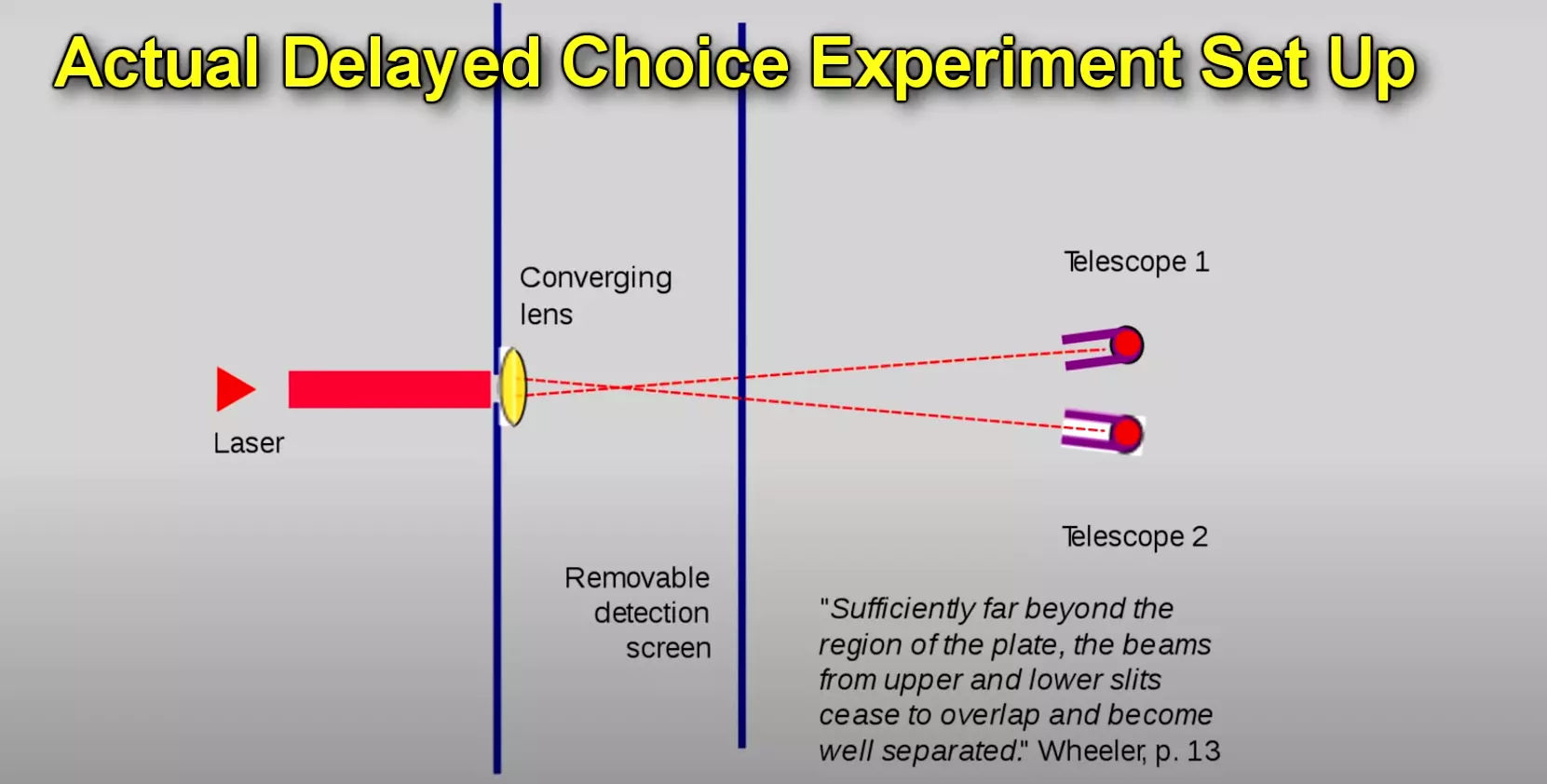 Delayed-choice double slit experiment setup by Wheeler
Delayed-choice double slit experiment setup by Wheeler
However, another more recent experiment used a more complex method to investigate the idea of the future influencing the past, by introducing something called a “quantum eraser” to the delayed choice. So, it’s called the Delayed Choice Quantum Eraser experiment, constructed by Kim, Kulik, Shih and Scully in 1999.
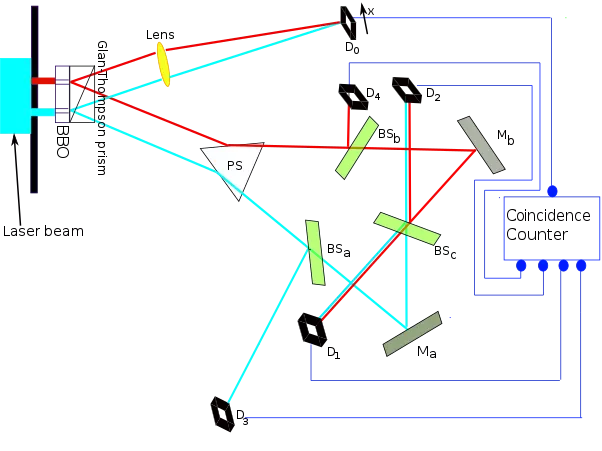 Simplified version of the setup constructed by Kim et al. (1999)
Simplified version of the setup constructed by Kim et al. (1999)
The actual experimental set-up is quite complicated, so we’ll use a simpler ‘skeleton’ model which is easier to understand.
The Experimental Set-Up
We start off with the standard double slit setup for firing photons – a suitable light source, a double slit, and a screen – the light reaches the screen once it passes through the double slit. To this, we add a Barium Borate crystal so as to split each incoming photon into an entangled pair of photons.
We pass photons from the light gun one at a time, each of which pass through one of the two slits. (of course, this isn’t technically correct; but for the purpose of understanding this part of the experiment, this classical way of looking at things is just fine.)
Each photon, after passing through the slit, gets split into an entangled pair of photons due to the BBO crystal.
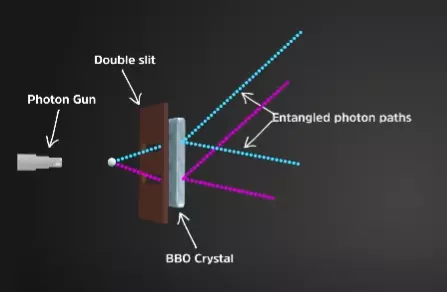
We use entangled photons so that we can measure one photon, without disturbing the other. Yet, measuring any one entangled photon will tell us about the nature of the other entangled pair, as both pairs must collapse in the same “state”, in the opposite sense (spin) by the laws of quantum mechanics.
Now, we introduce a lens near the top slit; this way, regardless of whether the entangled photon came from the bottom or the top slit, it will end up moving on the same path after being focused, and the detector placed after the lens won’t know from which slit the entangled photon originally came.
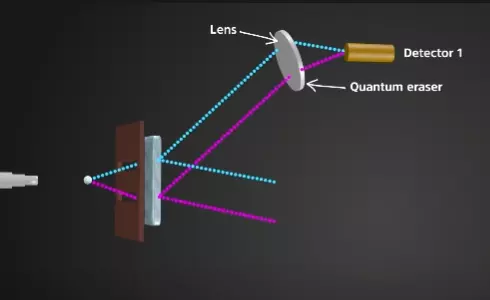
This lens thus erases the information of the path of the photon, and is called a “quantum eraser”.
Now, we pass the other entangled pair of a photon through a beam splitter. A beam splitter has a 50-50 chance of either diverting the beam, or allowing it to pass through.
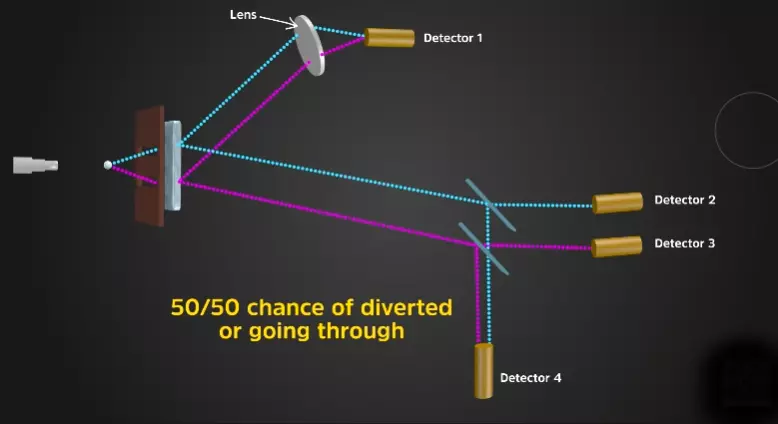
Thus, for the entangled pair of photons which are created at the top slit (blue), one of the photons passes through the quantum eraser and reaches detector 1. The other entangled pair encounters the beam splitter – and has a 50-50 chance of either passing through it and reaching detector 2, or getting diverted and passing into detector 4.
We place a similar detector (detector 3) and beam splitter for the entangled pair coming out of the lower slit, such that if the corresponding entangled photon is diverted, it also goes to detector 4.
The Experiment
Now, from the laws of quantum mechanics,
- The photon behaves as a particle if the which-way information is known.
- The photon behaves as a wave if the which-way information is erased.
Keeping this in mind, let’s start the experiment.
-
Detector 1 will give us either a particle interference pattern, or a wave interference pattern.
-
If detector 4 lights up, we can’t tell which slit the entangled pair was created from – thus, the path information has been erased if the beam is diverted,and we get a wave interference.
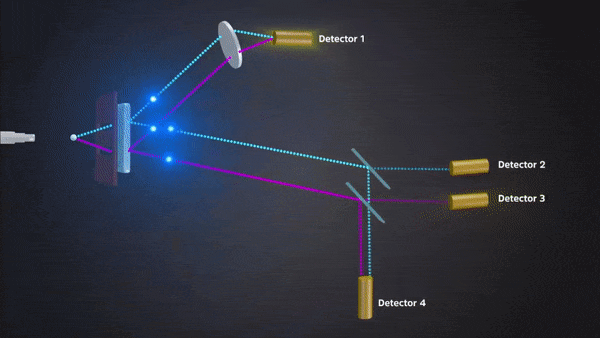
- If detector 2 lights up, we know that the entangled pair must have come from the upper slit – path information is preserved, we get a particle interference.
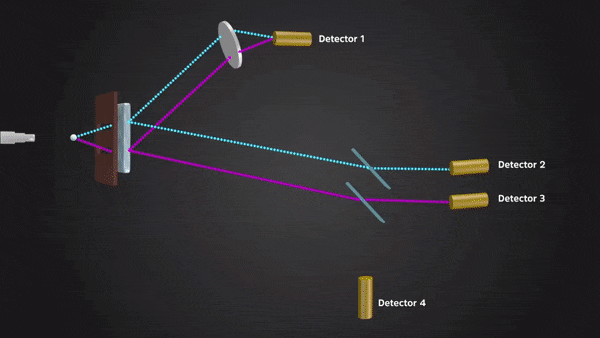
- If detector 3 lights up, we know that the entangled pair must have come from the lower slit - path information is preserved, we get a particle interference.
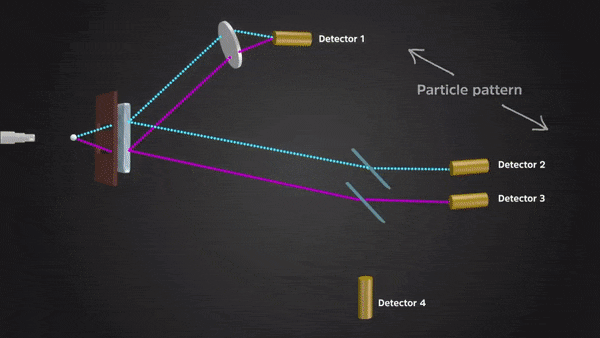
Now, so far, nothing seems out of the ordinary – or does it? Here’s the twist!

The distance between slits and detector 1 is much shorter than the distance between the slit and the beam splitter! What does that mean?
The decision for the photon to be a particle or a wave is made at the beam splitter! If the photon is deflected, it’ll provide a wave interference; elsewise, it’ll provide a particle interference. However, the photon reaches the beam splitter after it has reached – and created an interference pattern – at detector 1!
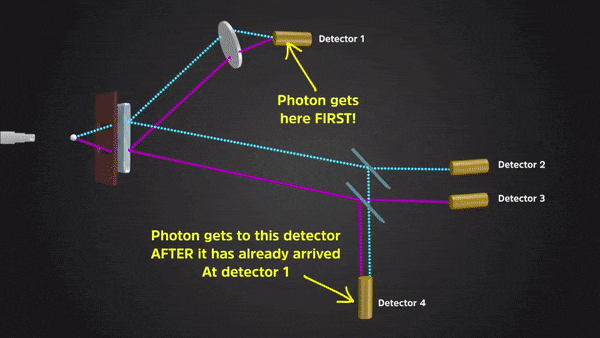
(Note: The above illustration combines the experiment for two separate entangled photon pairs, coming from the bottom slit and top slit - hence the blue and pink colored lines; the experiment is actually carried out one entangled photon pair at a time.)
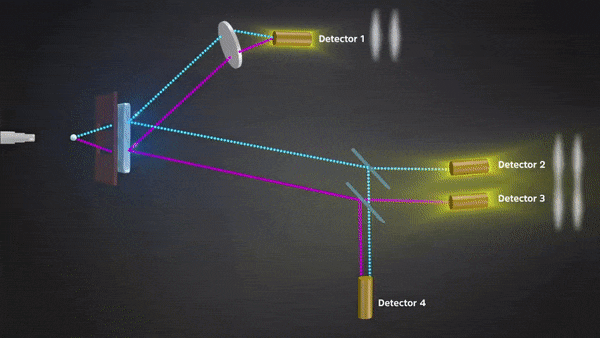
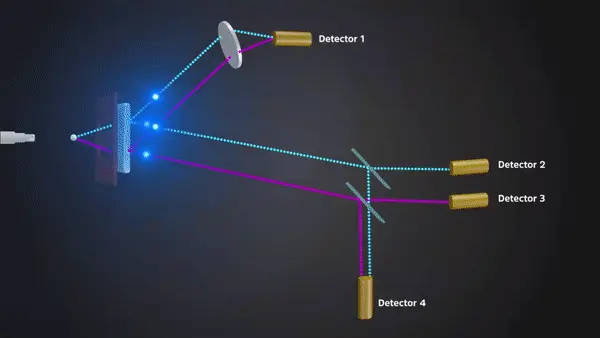
Essentially, the photon “decides” to behave as a particle or a wave at the beam splitter – after it has already created an interference pattern!
Does this mean that the ‘future’ decision (to behave as a particle or a wave) influences the ‘past’ (which pattern is shown by the entangled pair)? Although it may seem like this experiment is a definitive indicator of retrocausality, the results can be explained without invoking such a principle. The existing interpretations of quantum mechanics are sufficient in demystifying this experiment. Nonetheless, this experiment – which has been verified many times over – is an important test of our understanding of the foundations of quantum theory.
References
- Wheeler: Mathematical foundations of quantum theory - Google Scholar
- A Delayed Choice Quantum Eraser
- Delayed-choice quantum eraser - Wikipedia
- Questions of Principle (degruyter.com)
Edited by Aniket Kukreti
